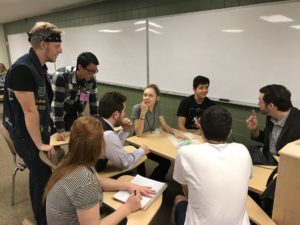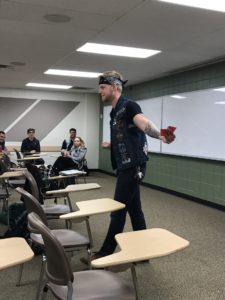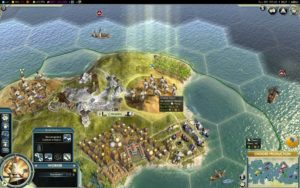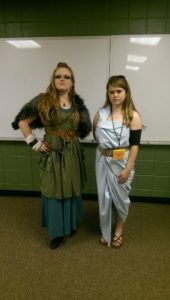Robert Jordan’s digital history course at CSU is not like any other history class. First-time visitors might feel like they’ve landed in the wrong century.

Several groups of students, some dressed up as Vikings and Romans, are discussing maps and strategy in hushed voices. After listening to their empire’s “national anthem” of Blue Swede’s “Hooked on a Feeling,” each group takes turns going to the front of the classroom, where Jordan relays information from Sid Meier’s Civilization V video game on his laptop. In a hushed circle around the screen, the instructor quietly tells each group about the newest developments in their virtual world and requests their next set of policy decisions.
“It looks like you have mountains with snowpack to your southeast,” Jordan tells one group. “Also, your new laborer is ready to begin construction of a farm.”
As unusual as it might seem, this kind of classroom environment is an exciting and effective way for students to engage with historical learning using role-playing and the latest digital simulations of living worlds. Jordan and a colleague from his graduate school days, Andrew Wilson, created the hybrid learning environment they call ImmerCiv through the synthesis of “gamified” roleplaying curriculum and the dynamic virtual environments of contemporary video games. Students in the upper-division course pretend to be citizens within a fictional ancient society controlled by the students’ ability to work together as a functioning government.
Brings it to life
“I’m more excited to come to this class because I know we’re going to do something different,” says junior Brittney Zemlicka. “I didn’t understand before that history can be more than a book. It’s so much more by adding a digital component to it — I feel like it brings it to life in a way that makes you want to learn more about it.”

Simulated inside the game environment, collective decisions by the student-run groups rapidly play out across centuries of time and across entire continents of historical space, so that the students can see the consequences of their actions.
“For a lot of students, this really does humanize history in a big way,” Jordan says. “Students tell me they ended up doing more for this project than they would have for a traditional project, because it’s fun. But they’re also learning — it’s like chocolate-covered broccoli.”
Within this virtual society, the four groups of students each represent an ideology, and every student within a group has a certain occupation, such as scientist, soldier, politician, journalist, priest/priestess or banker. Each of the four ideologies — Totalitarians, Capitalists, Marxists, and Anarchists — have to make decisions on issues like warfare, trade, diplomacy, scientific research and the environment.
“They need to know their ideology and act accordingly, plus they need to know what the other groups are likely to do,” Jordan says. “You may want to automatically attack a group and take what they have, but what if you’re playing a pacifist?”
Historical insight
Since only Jordan is able to see what is happening in the game, the students make collective, collaborative decisions with limited — and at times biased — information, giving them an authentic and relatable impression of how mistakes were made in history.
“Are the barbarians in an encampment?” one student whispers to Jordan during another group huddle. “According to our ideology, I think we should just remain defensive.”

Students have to do research outside the game scenario and are encouraged to continually seek out books, databases, archives and libraries for further information on a variety of historical subjects — which helps them “level up” their character’s abilities used in ImmerCiv. Their eventual grade in the class depends in large part on their level of historical engagement. They can gain extra points by dressing in historical costumes, creating propaganda, and producing cultural works, all from their characters’ historical perspectives.
“The game itself is very competitive — part of the motivation is certainly the desire by student groups to beat each other,” Jordan says. “They’re kind of holding up their cards and playing poker. Maybe one group is researching ironworks to gain a military advantage and doesn’t want the other groups to know. The level of detailed understanding needed to succeed in the game compels students to learn everything from what they eat to how they talk.”
Peer interaction

The game puts each student in a position to teach their peers and learn from them as well, giving the students a more active role in their own education and creating opportunities for growth as a leaders, communicators and negotiators. ImmerCiv effectively flips the classroom, as students research, write and deliver presentations.
“It really helps your social skills,” Zemlicka says. “Our team even meets outside of class to brainstorm what we can do with the game.”
“I definitely feel more connected to my classmates than I would in a normal history class,” junior Allison Spontarelli adds.
They have their work assessed via student peer review before they come to class, by a “high council” that is led by a teaching assistant and an equal number of representatives from each group. While in class, they share their work and use their content knowledge to respond to the complex historical push-pull factors at play within the simulation. To “win” the game, students within each ideological group must rely on each other’s expertise to collaboratively deal with the difficulties of gameplay factors while adhering to their ideological mindset.
A blast
“It definitely gets me more involved, because of the unconventional methods Dr. Jordan uses,” Spontarelli says. “This class has been a blast.”
The hybrid of a physical, digital and gamified classroom environment gives the students the chance to produce and critique each other’s content produced for the game, learn a variety of digital and academic skills while advancing their character, develop nonteachable skills and learn collaboratively from one another, beyond traditional teaching methods.
“In this kind of learning environment, you’re more able to identify and encourage qualities in students that you would never see otherwise,” Jordan says. “Some of them really come out of their shells, growing as junior scholars and being able to see more clearly the connections between the past, the present and themselves.”
The Department of History is in CSU’s College of Liberal Arts.